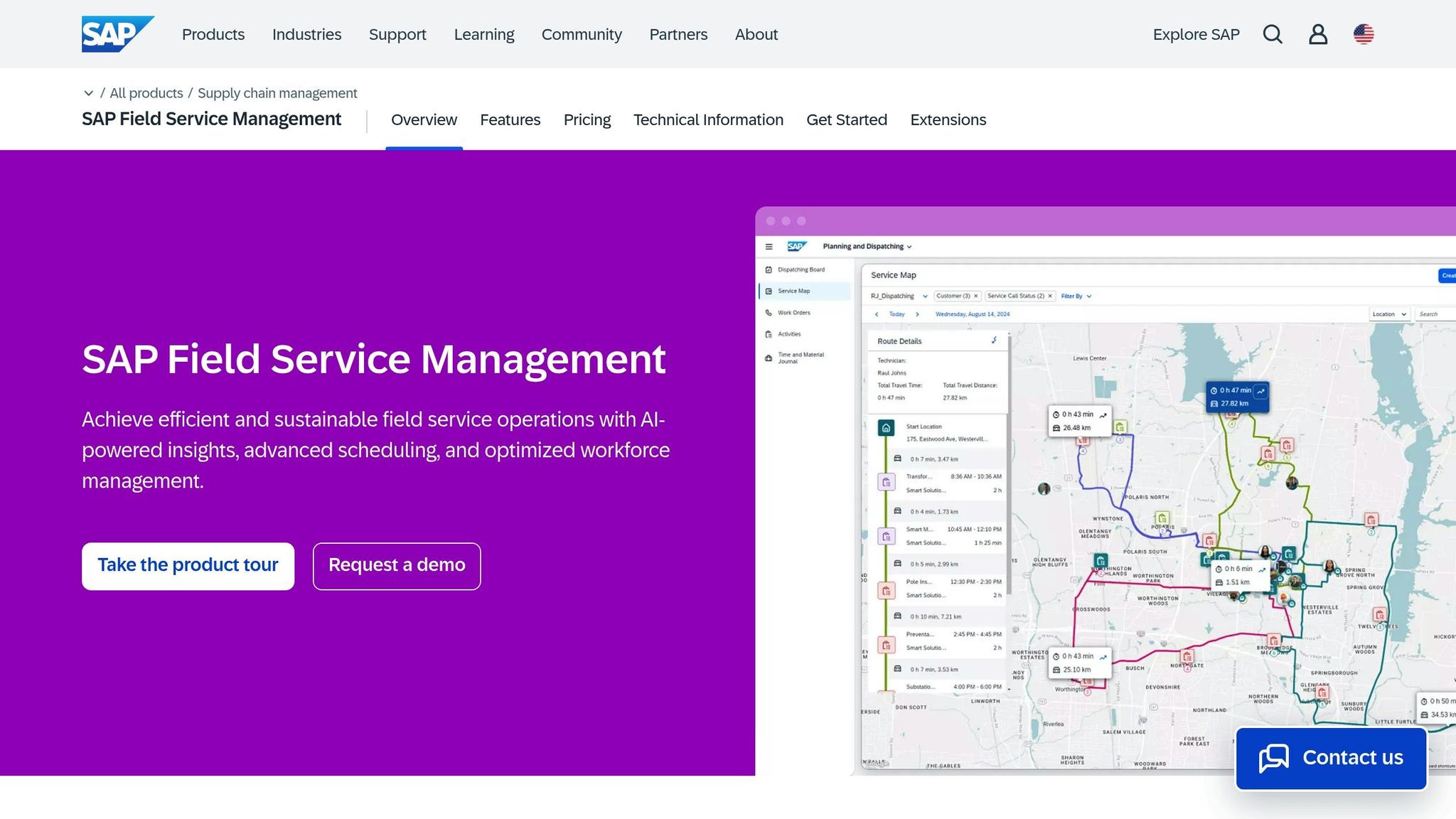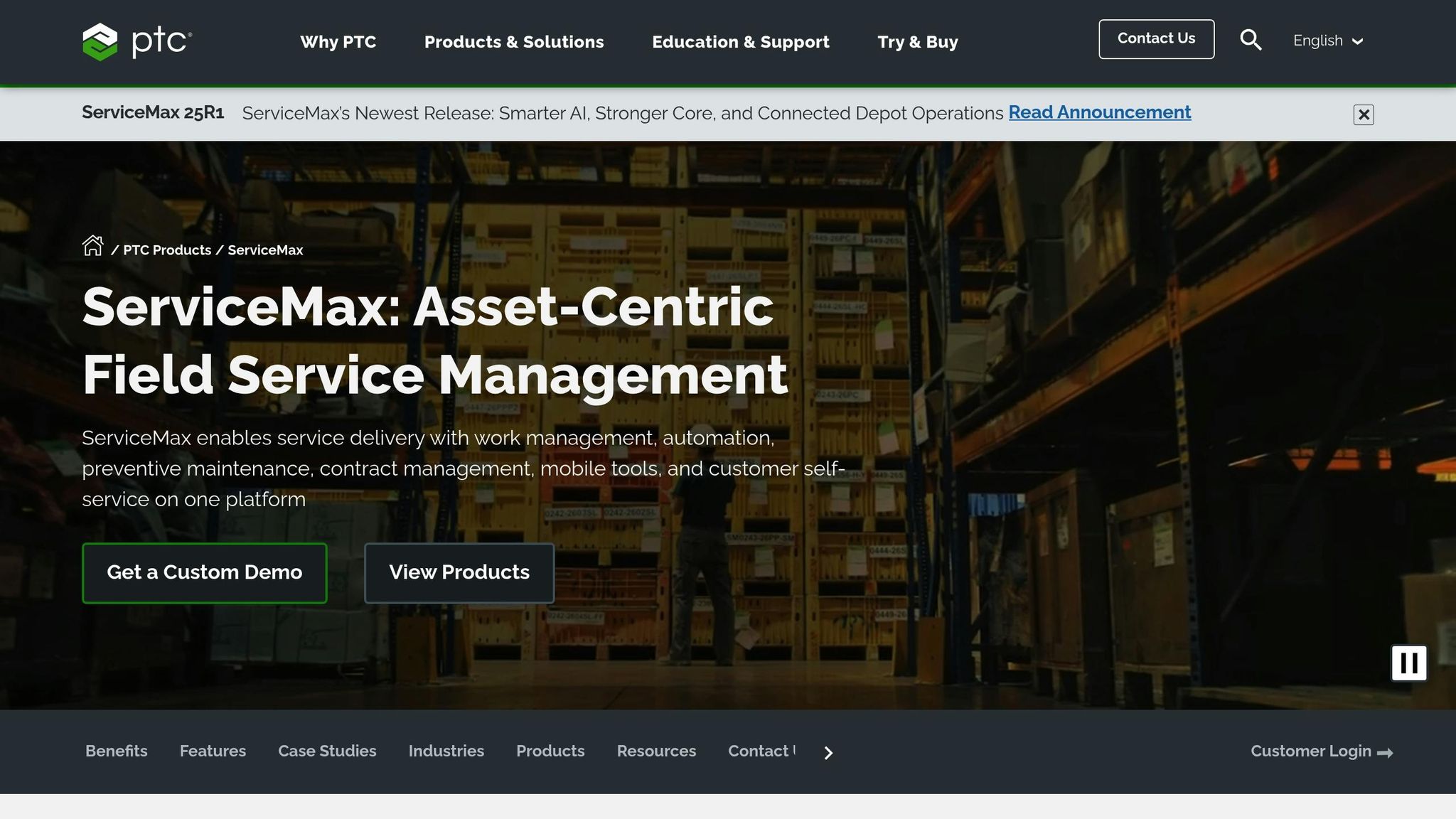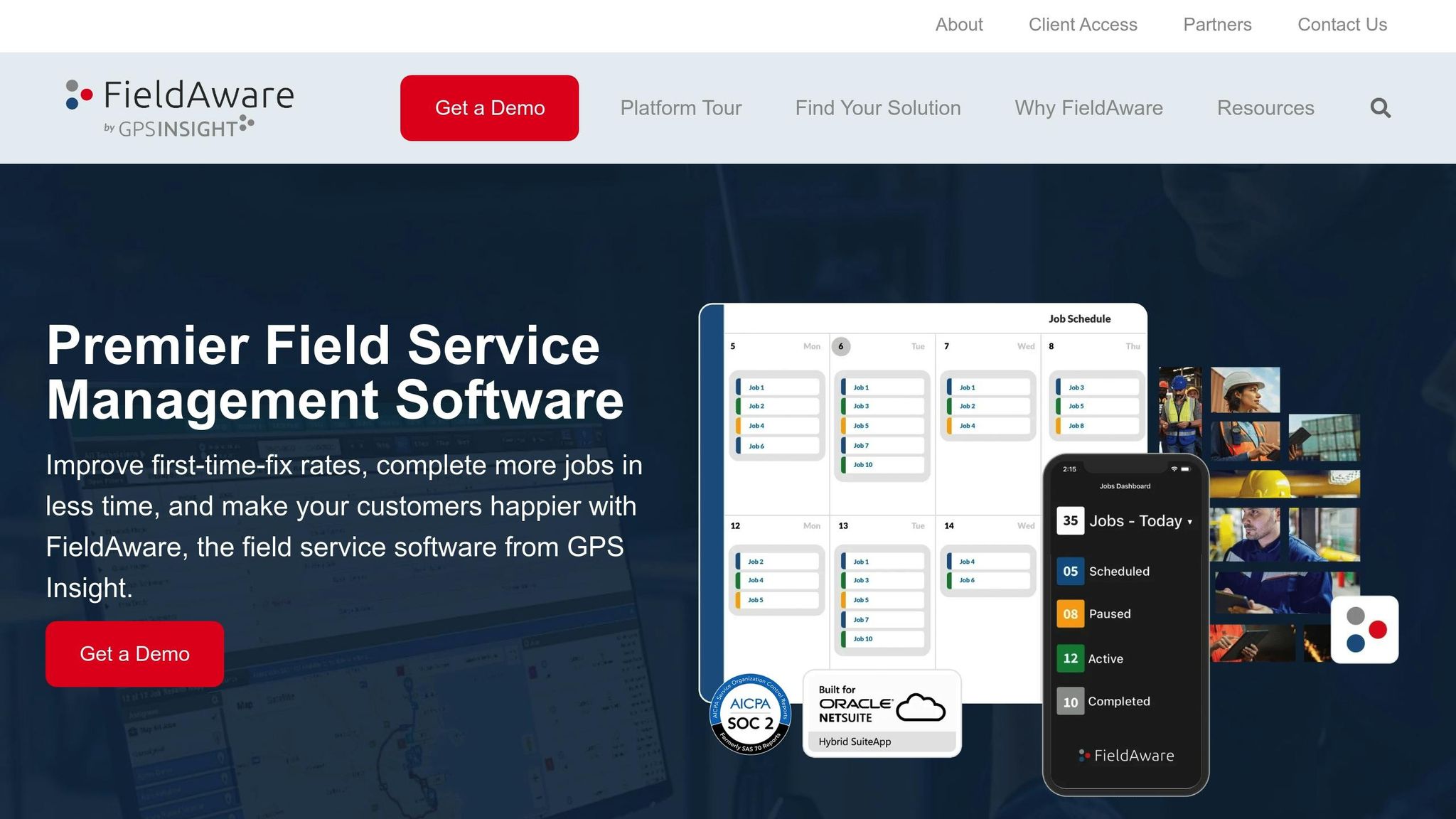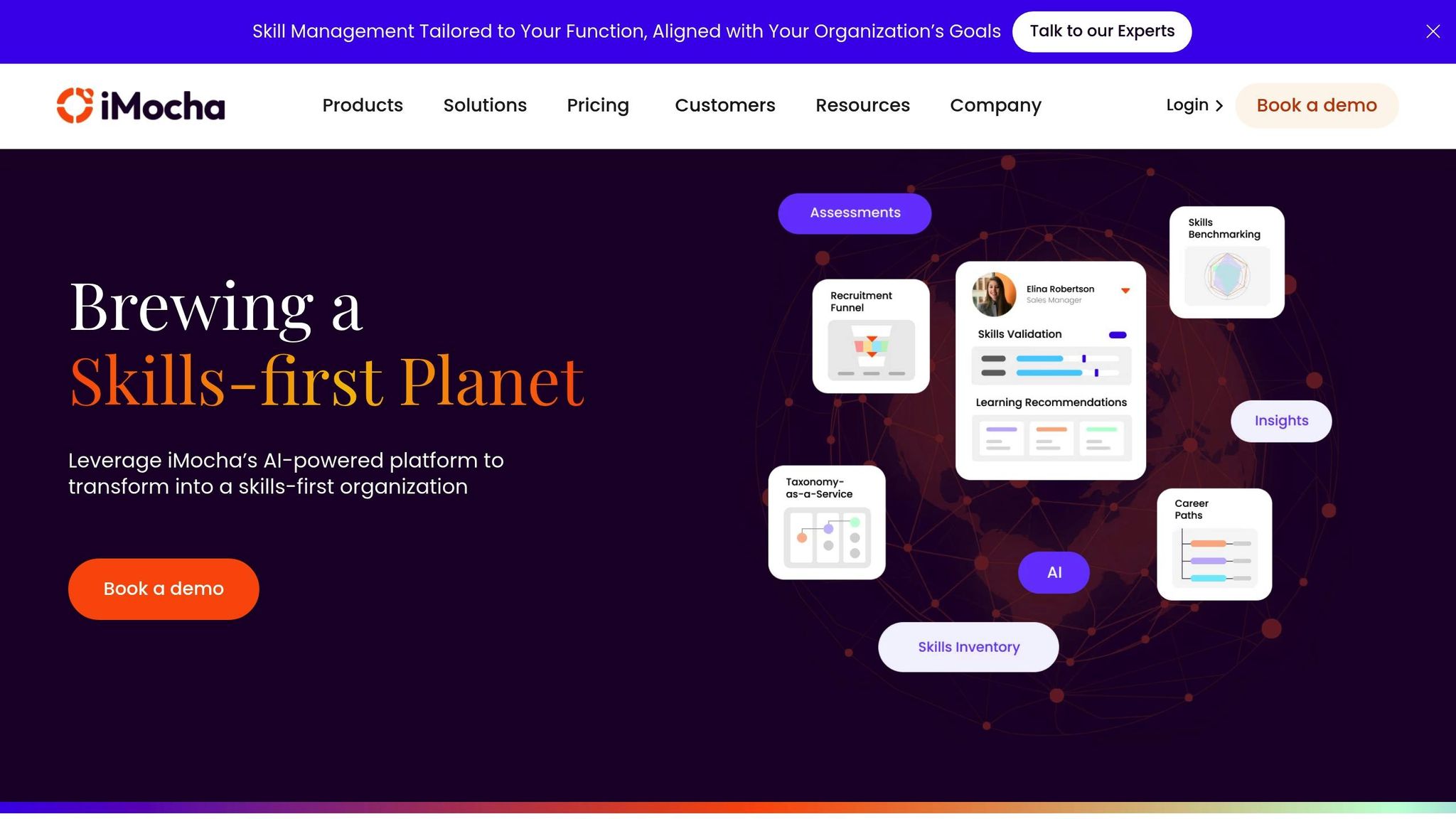
Best AI Software for Telecom Workforce Management
Telecom companies are turning to AI to tackle workforce challenges like scheduling, technician deployment, and resource allocation. With the AI telecom market projected to grow from $3.41 billion in 2024 to $19.42 billion by 2029, choosing the right software is key. This guide reviews seven top platforms that optimize workforce management:
- SAP Field Service Management: Ideal for large enterprises with complex needs, offering advanced scheduling and integration with SAP systems.
- GE Digital Workforce Management: Excels in predictive analytics and asset monitoring, tailored for industrial telecom operations.
- ServiceMax: Built on Salesforce, it focuses on AI-driven scheduling and predictive maintenance with strong mobile support.
- FieldAware: Affordable for mid-sized telecoms, offering simple deployment and integration with ERP systems.
- Skedulo: Cloud-based platform with AI scheduling, suited for growing businesses needing scalable solutions.
- iMocha: Focused on skills assessment and workforce training with broad integration capabilities.
- NICE WFM: Designed for telecom contact centers, offering AI-powered forecasting and real-time adjustments.
Each platform has strengths, from advanced analytics to mobile-first designs, with pricing models ranging from fixed subscriptions to custom enterprise plans. The right choice depends on company size, budget, and operational complexity.
Quick Comparison
| Solution | Key Features | Best For | Pricing Model |
|---|---|---|---|
| SAP Field Service Mgmt | Advanced scheduling, SAP integration | Large enterprises | Custom pricing ($300K–$500K+) |
| GE Digital Workforce Mgmt | Predictive maintenance, analytics | Industrial-scale operations | Tiered ($150K+/year) |
| ServiceMax | Mobile-first, predictive maintenance | Field service-focused businesses | $99–$300/user/month |
| FieldAware | Easy deployment, ERP integration | Mid-sized businesses | $45–$125/user/month |
| Skedulo | AI scheduling, cloud-based | Growing telecom companies | $25–$75/user/month |
| iMocha | Skills training, HR integration | Training-focused organizations | $20–$80/user/month |
| NICE WFM | Contact center optimization | Telecom contact centers | Custom (part of CXone suites) |
AI workforce management tools can improve efficiency, reduce costs, and enhance service quality, making them a smart investment for telecom companies.
1. SAP Field Service Management

SAP Field Service Management is tailored for medium to large telecom enterprises, using advanced AI to streamline field operations like technician scheduling and route optimization.
AI-driven Scheduling
Efficient scheduling is a cornerstone of telecom operations, especially when it comes to minimizing downtime. This platform uses advanced algorithms to assign technicians based on their skills, certifications, and past performance. Predictive scheduling and optimized route planning further cut down on travel time and ensure quicker responses.
Integration Capabilities
One of the platform's strengths is its seamless integration with existing enterprise systems, particularly within the SAP ecosystem. It works effortlessly with SAP ERP and SAP Customer Experience, simplifying tasks like inventory management, billing, and customer service. Its compatibility with SAP S/4HANA - enabled through APIs and middleware - ensures smooth data exchange between back-office systems and field operations. Additionally, the platform supports APIs for integration with CRM, ERP, and other systems, reducing duplicate data entries and maintaining real-time information flow. This level of integration is especially beneficial for managing every stage of the customer contract lifecycle, from the first interaction to ongoing support.
Scalability
Designed to handle the complex demands of large telecom enterprises, SAP Field Service Management supports multiple teams and locations. Role-based access controls ensure that employees only see information relevant to their roles. Its cloud-based deployment offers flexibility and automatic updates, making it easier to scale operations as needed. However, smaller telecom providers might find this enterprise-level solution more than they require.
Pricing
SAP uses a customized pricing model, tailored to an enterprise's specific needs and scale of operations. Pricing discussions typically cover factors like the number of users, integration needs, and desired features, ensuring that companies only pay for what they use. The platform has received strong feedback, with an average customer rating of 4.5 out of 5 stars. It's also recognized by industry analysts as a top performer in field service management.
Next, we’ll take a closer look at GE Digital Workforce Management, another prominent player in telecom field service solutions.
2. GE Digital Workforce Management
GE Digital Workforce Management brings its extensive expertise in AI to tackle the unique challenges of telecom workforce management. By applying its proven strategies, it provides tailored solutions to meet the complex demands of this sector.
AI-driven Scheduling
One of the standout features of GE Digital’s approach is its use of predictive analytics and machine learning for scheduling. By employing Digital Twins, the platform can anticipate equipment issues and schedule technicians proactively. For instance, GE Vernova's Industrial Managed Services team leverages SmartSignal technology to monitor over 7,000 critical assets globally. This has resulted in customer savings exceeding $1.6 billion. This kind of proactive monitoring not only ensures timely maintenance but also reduces unnecessary service calls, improving overall efficiency.
Integration Capabilities
GE Digital excels in connecting machine data with analytics, offering a powerful suite of tools for operational management. Its portfolio includes HMI/SCADA systems, Asset Performance Management, and integrated cybersecurity solutions, all designed to enhance operational oversight. Additionally, its Advanced Distribution Management Solutions (ADMS) integrate with key systems to provide secure control over distribution networks and a unified view of assets.
Scalability
The platform is designed to support operations at scale, providing enterprise-wide visibility. With cloud-based OEE solutions, it enables businesses to operate efficiently on a large scale. Real-world results highlight its effectiveness: a platinum operator achieved a 10% increase in overall throughput alongside a 1.5% improvement in recovery, while a major mining company boosted throughput by 5.5% while cutting power usage by 2%. Bill Ruh, Chief Digital Officer of GE and CEO of GE Digital, emphasizes the importance of data-driven productivity:
"Industrials that unlock data to master asset productivity will be positioned to lead."
Pricing
GE Digital employs an enterprise-focused pricing model, tailored to the scale and scope of each implementation. Its solutions have demonstrated the ability to deliver up to a 20% efficiency gain when layered on top of traditional operational technology systems. Pricing is typically negotiated based on the specific requirements and extent of the digital transformation initiative.
This concludes the overview of GE Digital before diving into additional solutions.
3. ServiceMax

ServiceMax is a field service management platform designed to tackle the intricate workforce challenges telecom companies face. Built on the Salesforce platform, it combines AI-powered tools and seamless integrations to help improve operational efficiency and enable predictive maintenance.
AI-driven Scheduling
ServiceMax’s AI-powered scheduling system is designed to optimize operations and deliver measurable results. By leveraging machine learning, it can reduce travel time by up to 20% and increase first-time fix rates by 15%.
What sets it apart is its ability to utilize detailed field asset histories, including equipment data, service records, and past resolutions. This data powers intelligent scheduling and predictive maintenance, helping technicians access job-specific insights through ServiceMax AI Chat. It also automates time-consuming tasks like documentation and scheduling, while offering proactive recommendations for maintenance.
Johann Diaz, founder of Service Revolution Academy and former Customer Services Director, highlights the broader benefits:
"AI scheduling doesn't just make operations more efficient - it makes customers happier. Real-time updates, predictive scheduling, and even personalized service preferences all contribute to stronger loyalty and satisfaction."
Additionally, the platform automates parts and inventory management, predicting the components technicians will need before they arrive on-site. This approach not only reduces delays but also allows technicians to focus on higher-value tasks instead of administrative work.
Integration Capabilities
ServiceMax excels at integrating with existing telecom systems through a robust framework. It connects seamlessly with ERP and CRM platforms, reducing manual data entry and boosting accuracy across business processes. Being built on the Salesforce platform ensures smooth integration with Salesforce CRM and Service Cloud.
According to the Technology Evaluation Centers (TEC), ServiceMax supports all 16 integration features they track, earning a perfect 100% support score, slightly above the market average of 98.9%. This capability extends to IoT platforms like PTC ThingWorx, enabling remote monitoring and predictive maintenance.
For example, Xylem integrated its CRM with ServiceMax, which improved technician mobility, enhanced customer insights, and increased service revenue. Similarly, Elekta adopted ServiceMax for its field service management needs, utilizing IoT-enabled features like Connected Field Service with ThingWorx for proactive service delivery.
Patrice Eberline, VP of Global Services at ServiceMax, explains the platform’s integration philosophy:
"Together with Jitterbit, our customers can jumpstart their field service integration projects and ensure they are up and running on ServiceMax as quickly as possible."
These integration capabilities make ServiceMax a scalable and adaptable solution for telecom companies.
Scalability
ServiceMax is designed to handle the complexities of large enterprises, making it especially suitable for telecom companies with extensive service operations. While it supports smaller businesses, its architecture is tailored for the scale and intricacies of managing telecom workforces. Prebuilt workflows and templates further enhance its ability to manage growing operations efficiently.
This scalability is crucial as industry trends evolve. For instance, IDC predicts that 20% of service will be delivered by contractors in the near future. ServiceMax is equipped to manage a mix of internal and external workforces seamlessly.
McKinsey research also shows that telecom companies can increase workday efficiency by 20% to 30% by leveraging workforce management tools like ServiceMax. The platform’s scalable design supports this by providing a foundation for ongoing improvements and adaptability to new technologies.
Aly Pinder, program director at IDC, underscores the importance of scalability:
"As service operations become more complex, the ability to leverage cloud applications and platforms that are flexible and provide a framework for continuous innovation becomes more critical to success."
Pricing
ServiceMax follows a custom pricing model tailored to the needs of large enterprises. Unlike standardized pricing tiers, the cost depends on factors like implementation scope, number of users, and integration requirements. Pricing details are typically discussed during consultations with their sales team.
This personalized approach reflects the platform’s focus on meeting the unique demands of enterprises with complex service operations. ServiceMax’s flexibility in pricing aligns with its mission to deliver tailored solutions for businesses navigating intricate workforce challenges.
4. FieldAware

FieldAware is a field service management platform designed to simplify operations while maintaining seamless connectivity with existing business systems.
Integration Capabilities
One of FieldAware's standout features is its open architecture design, which allows telecom companies to integrate with various enterprise software solutions without overhauling their current infrastructure. It supports both pre-built connectors for platforms like NetSuite, QuickBooks, and CentralBOS, as well as custom API integrations. This setup enables the smooth exchange of critical information - such as customer history, job details, warranty information, photos, customer signatures, parts and tasks, and invoice data - between back-office systems and field teams. These features improve workflow efficiency, enhance coordination, and strengthen customer interactions.
Michael Mah, Vice President of IT at Spark Power, highlights the platform's integration capabilities:
"I recommend [FieldAware] because of the sheer power and simplicity from a user experience standpoint, but also the power of the integration capabilities with an ERP solution…plus, we have the ability to capture a lot of data and utilize that data in a lot of ways."
Generator Systems offers a practical example of FieldAware's integration success. In 2013, the company adopted FieldAware specifically for its compatibility with NetSuite ERP, which they had relied on for CRM, accounting, invoicing, and fixed assets management. Rob Somrak, CFO of Generator Systems, shares:
"We chose FieldAware because it's customizable, reliable and mobile. It supports the two thirds of our employees who are out in the field using smartphones. FieldAware also integrates seamlessly with NetSuite ERP, which we've used for CRM, accounting, invoicing and fixed assets since 2013."
These integration strengths deliver measurable results, with users reporting a 15–17% increase in revenue and improved employee retention.
Scalability
FieldAware is built to grow alongside your business. Its serverless cloud architecture allows it to scale efficiently, whether you're a small team or a large enterprise. This makes it particularly suitable for telecom companies experiencing rapid growth or seasonal demand shifts. The platform’s flexibility ensures businesses can adapt quickly to market changes or evolving customer needs.
The system also supports phased implementation, enabling companies to add features as required and expand into new regions with ease. FieldAware’s scalable scheduling tools are designed to handle increasing workloads and larger technician teams without sacrificing efficiency. Moreover, its customizable framework accommodates unique business workflows across diverse telecom operations.
According to FieldAware, their software can boost profitability by over 30% while cutting IT costs by 20%, thanks to its unlimited system capacity. The company explains:
"FieldAware provides a serverless, highly scalable cloud architecture that can be implemented quickly, giving companies the flexibility to adapt to shifts in markets or customer preferences."
Pricing
FieldAware takes a personalized approach to pricing, tailoring costs to align with each client’s specific operational needs. Rather than offering fixed pricing tiers, the platform collaborates with companies to develop pricing structures that fit their budget and workforce management requirements.
This custom pricing model underscores FieldAware's commitment to providing solutions that integrate seamlessly with existing systems, avoiding the need for costly infrastructure replacements. Businesses interested in FieldAware typically undergo a consultation process to determine the most suitable pricing for their unique needs.
5. Skedulo

Skedulo is a workforce management platform that uses AI to streamline field service operations for telecom companies. By focusing on smart automation and smooth integration, it tackles challenges like scheduling, maintenance, and deployment with precision.
AI-driven Scheduling
Skedulo’s AI-powered optimization engine fine-tunes schedules and routes to minimize errors, prevent staffing gaps, and keep tasks on track. According to a McKinsey study, smart scheduling can cut job delays by 67% and increase productivity by 29%. Skedulo users report completing 64% more jobs while reducing travel time by 17%. The platform also equips managers to handle scheduling conflicts and emergencies efficiently, ensuring operations run smoothly.
Integration Capabilities
Skedulo’s integration framework connects data from business operations, employee management, and customer interactions to automate scheduling and job assignments. It offers native integrations with tools like Salesforce, Zendesk, and Microsoft Dynamics 365, allowing telecom companies to use existing CRM data while optimizing service management. Additionally, it integrates with HR, payroll, and financial systems, such as Employment Hero Payroll, which provides real-time job costing estimates. For more specific needs, custom integrations can be built using its API and Skedulo Lens. This flexibility makes it easier for businesses to scale operations efficiently.
Scalability
Thanks to its cloud-based design, Skedulo can adapt to rapid growth and seasonal demand spikes. A great example is Connexin, a telecom company that received an $80 million investment in 2020. Connexin selected Skedulo for its ability to scale effectively. Emily Halsey, Engineering Operations Manager at Connexin, shared:
"Skedulo was scalable, and agile, which is exactly what we were looking for."
Since implementing Skedulo, Connexin has doubled its workforce in just one year, improved operations through automation, and strengthened collaboration between office and field teams.
Pricing
Skedulo offers customized pricing tailored to the specific needs of each telecom company. Factors like workforce size, integration requirements, and desired features are considered during a consultation process. This ensures businesses only pay for the tools and capacity they truly need.
sbb-itb-ef0082b
6. iMocha

iMocha leverages AI to streamline scheduling and provide actionable talent insights, helping telecom companies adapt to tech-focused business models and improve overall workforce efficiency.
AI-driven Scheduling
iMocha's AI-powered scheduling system is designed to optimize resource allocation by balancing operational costs with employee preferences. Using reinforcement learning, the platform dynamically adjusts schedules, leading to a 79% improvement in employee retention and a 58% increase in employee lifetime value. This smart scheduling seamlessly integrates with a wide range of applications, ensuring smooth operations.
Integration Capabilities
iMocha connects effortlessly with over 3,000 apps through Zapier and directly integrates with enterprise platforms like SAP SuccessFactors, Workday HCM, applicant tracking systems, and Microsoft Teams via Azure Cognitive Services. Its capabilities extend across Skills Intelligence, Talent Acquisition, and Talent Management, enabling telecom companies to incorporate skills-based decision-making into their HR strategies.
Scalability
iMocha is built to scale alongside the growing demands of the telecom industry. For instance, Ericsson expanded its technical certification program to over 1,000 employees using more than 4,000 assessments. Similarly, an Australian telecom company successfully reskilled 3,500 employees. Currently, iMocha supports 500+ organizations across 70+ countries, managing thousands of concurrent sessions with ease.
7. NICE WFM (by NICE CXone)

NICE WFM delivers a tailored workforce management solution designed specifically for telecom contact centers. By combining AI-driven forecasting with smart scheduling tools, it helps telecom companies streamline their operations while maintaining top-notch service quality.
AI-driven Scheduling
NICE WFM uses AI-powered omnichannel forecasting to craft efficient scheduling strategies for both short-term and long-term workforce needs. By analyzing historical data, the system predicts fluctuations in call volume and average handle time (AHT), allowing telecom companies to adjust staffing levels in advance.
The platform’s advanced forecasting models also enable real-time staffing adjustments. Administrators can configure performance parameters to fine-tune these predictions, ensuring accuracy and responsiveness.
One standout feature is the real-time schedule editing through automated intraday management. Managers can easily make manual changes using a color-coded, drag-and-drop interface. Meanwhile, NICE Intelligent Intraday Automation proactively handles adjustments, addressing potential issues before they escalate.
"NICE was the clear choice based upon multiple factors. We were looking for the best-in-class WFM cloud solution that would allow our worldwide operations to provide the best customer experience with operational efficiency and employee engagement by a solid organization that we trust to deliver anywhere in the world. NICE Intelligent Intraday Automation capabilities are impressive, and our decision was driven by an AI-powered approach and the speed and flexibility of the cloud." - Caio Poli, International Customer Experience Executive Director, DiDi Global
These advanced scheduling tools provide a solid foundation for seamless integration across systems.
Integration Capabilities
NICE CXone excels in integration, offering compatibility with existing telecom systems. It connects with multiple communication channels, including phone, email, SMS, and chat, which is essential for managing diverse customer interactions.
The platform supports integration with IVR systems for automated call handling and routing. It also connects with agent tools like MAX or Salesforce Agent via API calls. Additionally, NICE CXone integrates with NICE Engage through AppLink, enabling the import of users, media, metadata, and business data.
As a cloud-based solution, CXone eliminates the need for on-site installations. Users can access the platform through a web browser with an internet connection. It operates on Amazon Web Services (AWS) and ensures secure, encrypted connections with at least TLS 1.2 compliance.
Scalability
NICE WFM is built to scale, making it equally effective for small telecom providers and large enterprises. Its cloud-native design ensures it can handle operations of varying sizes.
"Whether you're a large enterprise managing a complex workforce or a smaller organization looking to streamline your scheduling processes, NICE WFM offers scalable solutions to meet your needs." - Anjali Agrawal, BuzzClan
Real-world results highlight its scalability. A major telecommunications company achieved a 15% improvement in schedule adherence and a 10% reduction in overtime costs after implementing NICE WFM. The platform effectively balances operational efficiency, employee satisfaction, and service quality for organizations of all sizes.
Pricing
NICE WFM is available as part of the NICE CXone contact center plans: Essential, Core, and Complete Suites. While exact pricing isn’t publicly available, it’s rated highly for its value, with Software Advice users giving it a 4.7/5 for cost-effectiveness.
User reviews reflect strong satisfaction with the platform. It scores 4.9/5 for functionality, 4.4/5 for ease of use, and 4.3/5 for customer support. One reviewer from a telecommunications company (1,001–5,000 employees) shared:
"Overall, NICE is really nice and easy to use. It is organized and effective"
The reviewer also praised its real-time features, simple processes for correcting time stamps, and efficient data extraction. With benefits like a 40% reduction in agent absenteeism and an ROI of up to 60%, NICE WFM offers a strong case for telecom companies looking to enhance workforce management.
Advantages and Disadvantages
Building on our software comparisons, let’s dive into the overall benefits and challenges of AI in telecom workforce management. Each solution comes with its own strengths and trade-offs, and understanding these can help companies make informed decisions tailored to their needs and budgets.
Comprehensive Solution Comparison
Here’s a quick breakdown of the key strengths, limitations, and pricing for the reviewed solutions:
| Solution | Key Strengths | Main Limitations | Pricing Structure |
|---|---|---|---|
| SAP Field Service Management | Scalable for enterprises, strong integration capabilities, advanced analytics | Complex implementation, steep learning curve, high upfront costs | Custom pricing, typically $300,000–$500,000+ for telecom setups |
| GE Digital Workforce Management | Reliable for industrial use, integrates predictive maintenance, proven in utilities | Limited customization, resource-heavy deployment, depends on legacy systems | Tiered subscriptions, starting at $150,000+ annually |
| ServiceMax | Mobile-first design, user-friendly, focused on field services | Limited workforce planning, challenges integrating with legacy systems | Per-user monthly pricing, $99–$300 per user |
| FieldAware | Affordable for mid-sized businesses, quick to deploy, easy to use | Not ideal for large enterprises, fewer advanced AI features | Subscription-based, $45–$125 per user per month |
| Skedulo | Flexible scheduling, strong mobile tools, modern cloud architecture | Limited reporting, newer platform with evolving features | Usage-based pricing, $25–$75 per user per month |
| iMocha | Specialized in skills assessment and training, AI-powered learning | Narrow focus on training, needs integration with other tools | Modular pricing, $20–$80 per user per month |
| NICE WFM | Excels in contact centers, real-time optimization, proven ROI | Focused more on contact centers, lacks field service capabilities | Part of CXone suites, custom pricing with reported 60% ROI |
Strategic Advantages Across Solutions
AI-powered workforce management systems bring measurable benefits to telecom operations. For example, they can boost sales conversions by up to 15% and reduce capital expenditures by 10%. These tools automate repetitive tasks, optimize resource allocation, and provide real-time insights, making operations more efficient.
One of the standout advantages is the shift from reactive to proactive management. By analyzing network data in real time, AI helps telecom companies predict and address potential issues before they disrupt service. For instance, AT&T uses AI to monitor data from cell towers and fiber optic cables, identifying early signs like signal degradation to prevent network failures.
Predictive maintenance is another game-changer. AI can forecast equipment issues and performance dips, cutting unexpected downtime by up to 50% and reducing maintenance costs by as much as 40%. This capability is particularly valuable in maintaining service quality and minimizing disruptions.
Common Implementation Challenges
Despite their benefits, these solutions often come with challenges. Telecom-specific implementations require significant upfront investments, often ranging between $300,000 and $500,000+. This makes careful planning and executive support essential.
Integration is another hurdle. While cloud-based systems simplify deployment, connecting them with existing telecom infrastructure often requires custom solutions. Companies must weigh their desire for advanced features against technical constraints and budget realities.
Employee training and adoption are also critical. These systems demand new skills and a shift to automated workflows, which can be daunting for teams. However, effective AI training has been shown to improve employee retention rates by 15%. Investing in training is key to overcoming resistance and ensuring smooth adoption.
ROI and Performance Metrics
The financial returns from AI investments are compelling. On average, companies see a 3.5X return, with some reporting as much as 8X. Performance improvements include a 20% boost in efficiency and a 25% reduction in legal risks.
Rather than replacing human workers, AI enhances their capabilities. Companies that succeed with these systems focus on upskilling their workforce and creating specialized roles.
The telecom industry’s projected growth - from $3.41 billion in 2024 to $19.42 billion by 2029 - emphasizes the importance of choosing the right workforce management solution. Strategic investments in AI-driven systems can help businesses thrive in this expanding market while maintaining efficiency and service excellence. These insights lay the groundwork for further strategic considerations.
Final Thoughts
Selecting the right AI workforce management software hinges on factors like your organization's size, budget, and operational complexity. With the telecom industry's AI market experiencing rapid growth, making an informed choice has never been more crucial.
For large enterprises managing complex, multi-site operations, solutions such as SAP Field Service Management or GE Digital Workforce Management are strong contenders. These companies dominate the market, holding a 67.0% share of the AI in Workforce Management Market. Their ability to invest in advanced AI solutions - priced between $100,000 and $500,000+ - often pays off, delivering an average return of 3.5X on their AI investments. On the other hand, smaller telecom providers often lean toward simpler, budget-friendly options.
Small and medium-sized businesses (SMBs) typically prioritize affordability and ease of implementation. Platforms like FieldAware and Skedulo cater to these needs by offering mobile-friendly, straightforward solutions. Even smaller telecom companies can see substantial gains, as shown by 85% of businesses reporting increased productivity after adopting workforce management tools.
The key to success lies in aligning software capabilities with organizational objectives. With AI adoption becoming widespread in telecom, the real question isn't whether to adopt these tools but how to do so effectively. Pilot projects are a smart starting point, allowing companies to validate ROI before scaling up. The focus should remain on measurable outcomes like cost efficiency, improved service reliability, and enhanced subscriber satisfaction.
Equally important are data quality and system integration. The IT and telecommunications sector accounts for 24.5% of the AI in Workforce Management Market, highlighting the industry's strong adoption. To ensure success, companies must carefully assess their existing infrastructure and invest in thorough employee training.
Looking ahead, AI workforce management tools are projected to boost productivity by 15% to 25% over the next three to five years. Organizations that align their technology investments with operational realities will be better positioned to enhance workforce management processes and achieve long-term success.
FAQs
How do AI workforce management tools help telecom companies improve efficiency and reduce costs?
AI workforce management tools are transforming how telecom companies operate by making processes more efficient and cutting costs. These tools improve technician scheduling, take over routine tasks, and support proactive maintenance efforts. The result? Less downtime and smarter use of resources. In fact, companies can slash operational costs by as much as 30% while still delivering top-notch service.
On top of that, AI fine-tunes workflows and strengthens network management. This allows telecom providers to manage more work without driving up expenses. The outcome is a workforce that runs more smoothly, resolves issues faster, and keeps customers happier - all while saving both time and money.
What should telecom companies look for when selecting AI software for workforce management?
When selecting AI software for workforce management, telecom companies should zero in on a few critical aspects. Start by examining how the software can boost efficiency. Features like automated scheduling, predictive analytics, and tools for enhancing customer interactions can simplify processes and improve service quality.
Next, weigh the cost-effectiveness of the solution. Compare the potential savings it offers against the costs of implementation. Opt for software that integrates smoothly with your current systems and demands minimal training for your team. At the same time, make data security and privacy a top priority to ensure compliance with industry regulations and safeguard sensitive information.
Lastly, consider the provider's support and scalability. The right software should be capable of growing alongside your business, adapting to evolving demands without sacrificing reliability or performance.
How does AI improve workforce scheduling and prevent downtime in telecom operations?
AI plays a big role in improving workforce scheduling by analyzing data to allocate staff more efficiently. This means customer inquiries get handled faster, cutting down wait times and boosting customer satisfaction.
On top of that, AI-powered predictive maintenance can spot potential equipment issues before they turn into problems. By addressing these issues early, companies can prevent service interruptions and keep telecom operations running without a hitch. These AI tools work hand-in-hand to enhance service quality while minimizing disruptions in day-to-day operations.
Related Posts
How AI Predicts Customer Behavior in Telecom
Explore how AI is revolutionizing the telecom industry by predicting customer behavior to enhance service delivery and retention strategies.
Top 7 AI Tools for Telecom Service Activation
Explore the top AI tools revolutionizing telecom service activation, enhancing efficiency and reducing errors in operations.
Improving Telecom Customer Experience with Predictive AI
Explore how predictive AI enhances telecom customer service through proactive problem-solving, personalized experiences, and cost efficiency.
AI for Telecom Service Quality Prediction
Explore how AI is revolutionizing telecom service quality prediction and enhancing customer interactions for small and medium-sized businesses.
